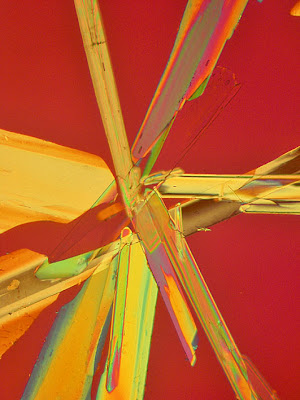Many years ago, when I was a student, I was given this box of old prepared microscope slides. I can't remember who the donor was but they've been at the back of a cupboard for years and only emerged when I was having a clear-out, a couple of months ago.
They date from around the time of the First World War. Some were commecially prepared by the firm of Watson & Son, of 313, High Holborn, London - labelled with beautiful handwriting, in mounts that were so well ringed with shellac that they have remained in perfect condition for almost a century.
Others were prepared by the original owner, who I'm guessing must have been a chemist because many are cystalised mounts of chemical compounds, intended to be viewed with polarised light, made from substances that would only have been available to a professional chemist - possibly a plant biochemist because quite a number of the crystals are naturally-occuring plant compounds that he might have extracted and purified himself. One contains the only clue to the identity of the mystery microscopist, because he has written his name in chemical crystals on the slide - 'SID'.
Sid would have looked at these specimens with a rather primitive instrument called a Fox Polariscope - so Sid probably wouldn't have seen the images in quite the same vibrant colours that you can see here, achieved with a modern polarising microscope. The specimen above is strychnine...
... this is floridzin, an alkaloid from apple roots...
...as is this one, too.
This is mercuric cyanide
Salignin...
Coumarin, the compound responsibe for the scent of new-mown hay...
Salicin, extracted from willow bark and the precursor of salicylic acid ,better known as aspirin...
... and ammonium bitartrate





























